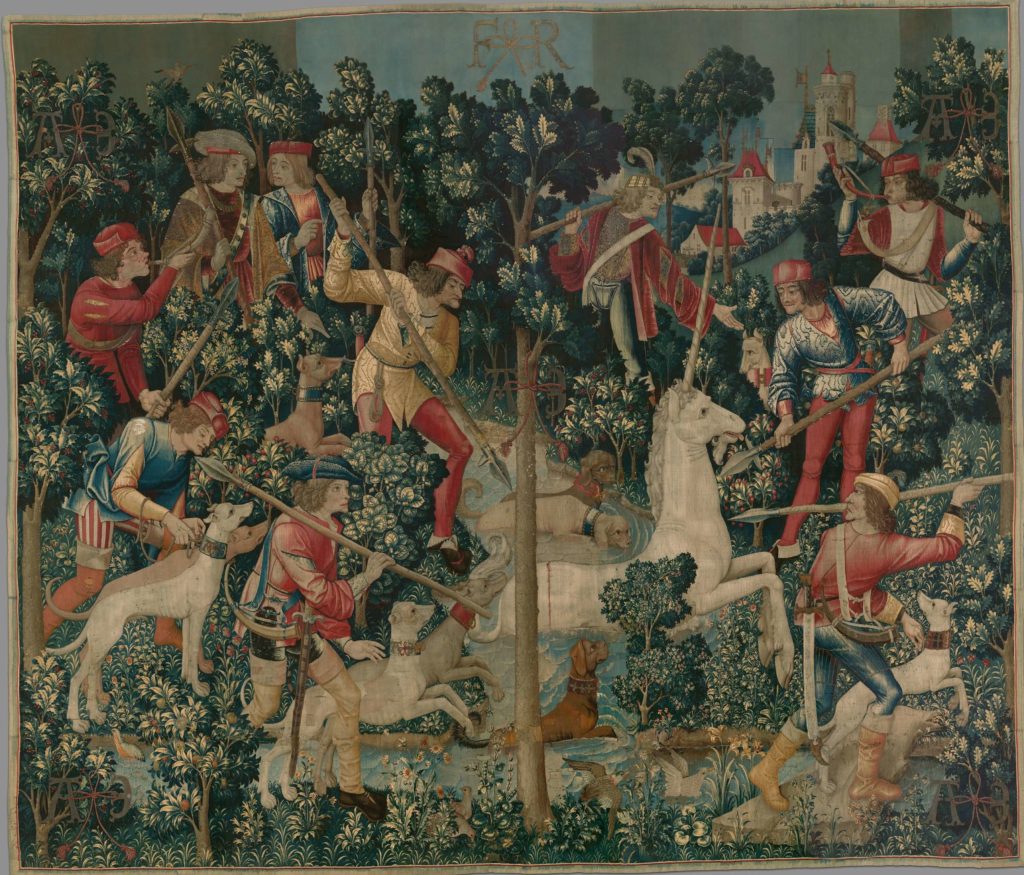Nun, Scientist, Artist, Saint: Meet Hildegard von Bingen
Saint Hildegard von Bingen (1098-1179), also known as the Sybil of the Rhine, is one of the most renowned figures from the European Middle Ages. She...
Iolanda Munck 18 July 2024
4 October 2024 min Read
The Unicorn Tapestries are a set of medieval tapestries depicting a hunt for a unicorn, a popular motif at the time. They’re probably the most famous tapestries ever, and they’re definitely among the most famous medieval artworks.
The Unicorn Tapestries include seven large panels. They are all from the Southern Netherlands, 1495-1505. They have two possible interpretations, and both are based on medieval unicorn symbolism.













The first five tell a story based on medieval stag hunts, only with a unicorn substituted for the stag. These panels show everyone who would have been involved with a stag hunt, including a nobleman, hounds, horses, and all the people who actually conduct the hunt. While these are attractive scenes with bright colors and lush foliage, they can also be very violent. After all, they end with the unicorn’s death. The remaining two panels more clearly address the symbolism unicorns had in the Middle Ages.




According to medieval mythology, only a maiden could subdue a unicorn. The panel called the Mystic Capture of the Unicorn is only two fragments, but it would have originally shown a young maiden taming the unicorn. She isn’t the woman in the red dress, though. There was once a second woman in the image. In the Unicorn in Captivity, which is probably the most famous of the panels, the unicorn is confined to a garden, probably because the maiden put him there.
There are two possibilities as to what this means. One is that the unicorn is a symbol of Christ, and the maiden who tames him refers to the Virgin Mary. In this sense, the hunt for the unicorn refers to the crucifixion. People in the Middle Ages believed that the unicorn’s horn had healing powers, so it makes sense that they saw parallels with Christ. Under this interpretation, the Unicorn in Captivity panel might represent the risen Christ since it shows the unicorn alive after being killed in the hunt.




The second possibility is that the unicorn represents a happy husband tamed by his love for the maiden. This was a common feature of the courtly love poems popular at this time. In this case, the garden may represent something called a hortus conclusus, which was a medieval symbol of fidelity. The chain holding the unicorn inside the garden is called a chaîne d’amour, and it is also featured in courtly love poems.




Five of the seven Unicorn Tapestries are full of naturalistic plant and animal details. In fact, there are over 100 species of plants depicted in the Unicorn Tapestries, and most of them are identifiable. The other two tapestries (The Hunters Enter the Woods and The Unicorn in Captivity) have an all-over floral background called millefleurs, which is French for a thousand flowers. It’s this difference that makes people think that the tapestries were not meant to be one cohesive set. Some scholars think that the tapestries originally hung in a bedroom, with the first five panels on the walls and the other two over the bed.












Unfortunately, nothing is known about the Unicorn Tapestries’ original owners. The “AE” monogram that appears on five of the panels and the “FR” monogram on another one provides clues to support a few different theories. American financier J.P. Morgan eventually purchased the panels and donated them to The Met Cloisters in New York. There, they appear in a gallery set up to mimic the sort of medieval room where they probably hung originally.












Freeman, Margaret B., The Unicorn Tapestries. New York: Metropolitan Museum of Art, 1976.
Metropolitan Museum of Art collection database entries on the Unicorn Tapestries: “The Hunters Enter the Woods“, “The Unicorn is Found“, “The Unicorn is Attacked“, “The Unicorn Defends Itself“, “The Unicorn is Killed and Brought to the Castle“, “The Mystic Capture of the Unicorn“, and “The Unicorn in Captivity“. Accessed 29 Nov 2021.
DailyArt Magazine needs your support. Every contribution, however big or small, is very valuable for our future. Thanks to it, we will be able to sustain and grow the Magazine. Thank you for your help!